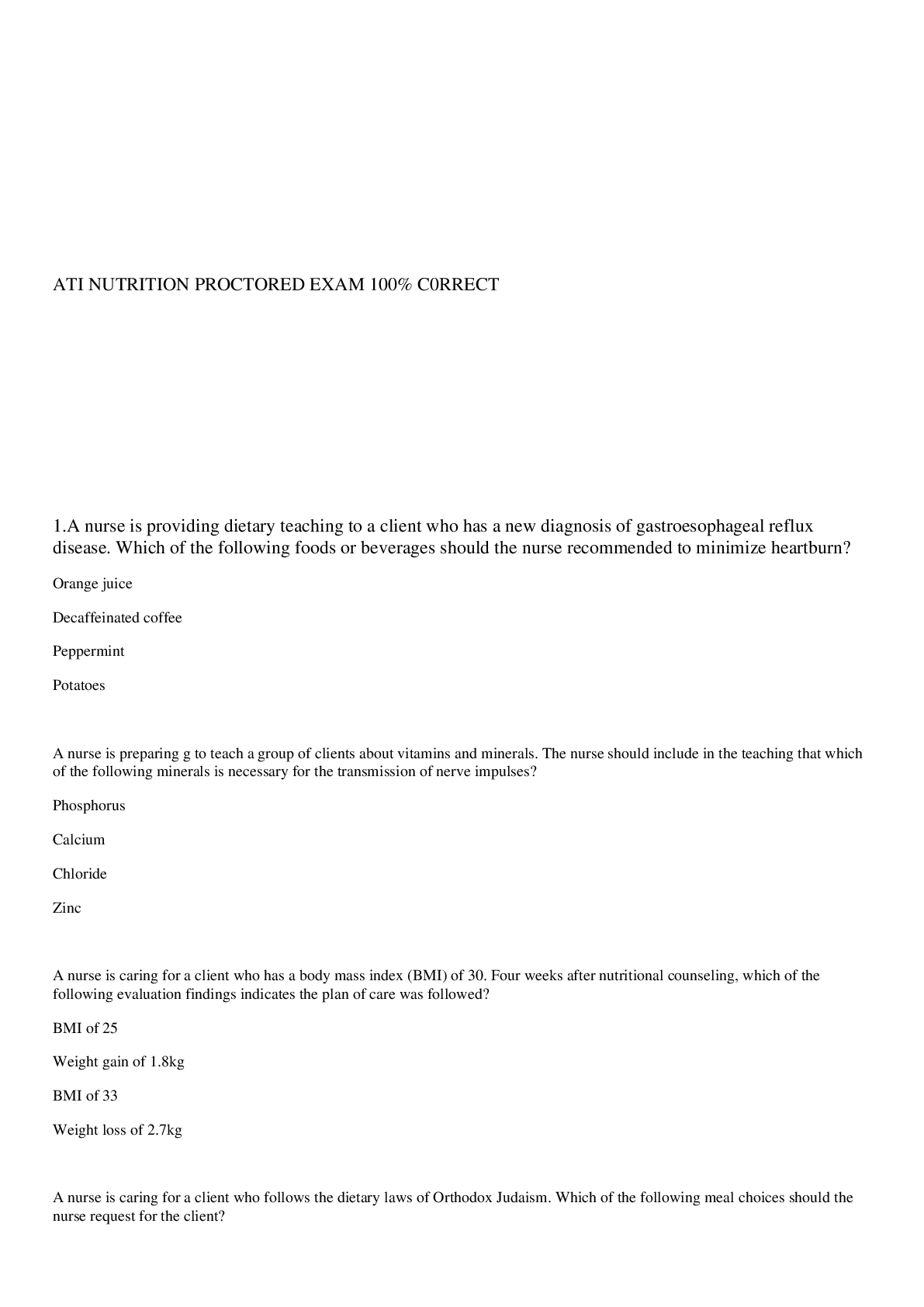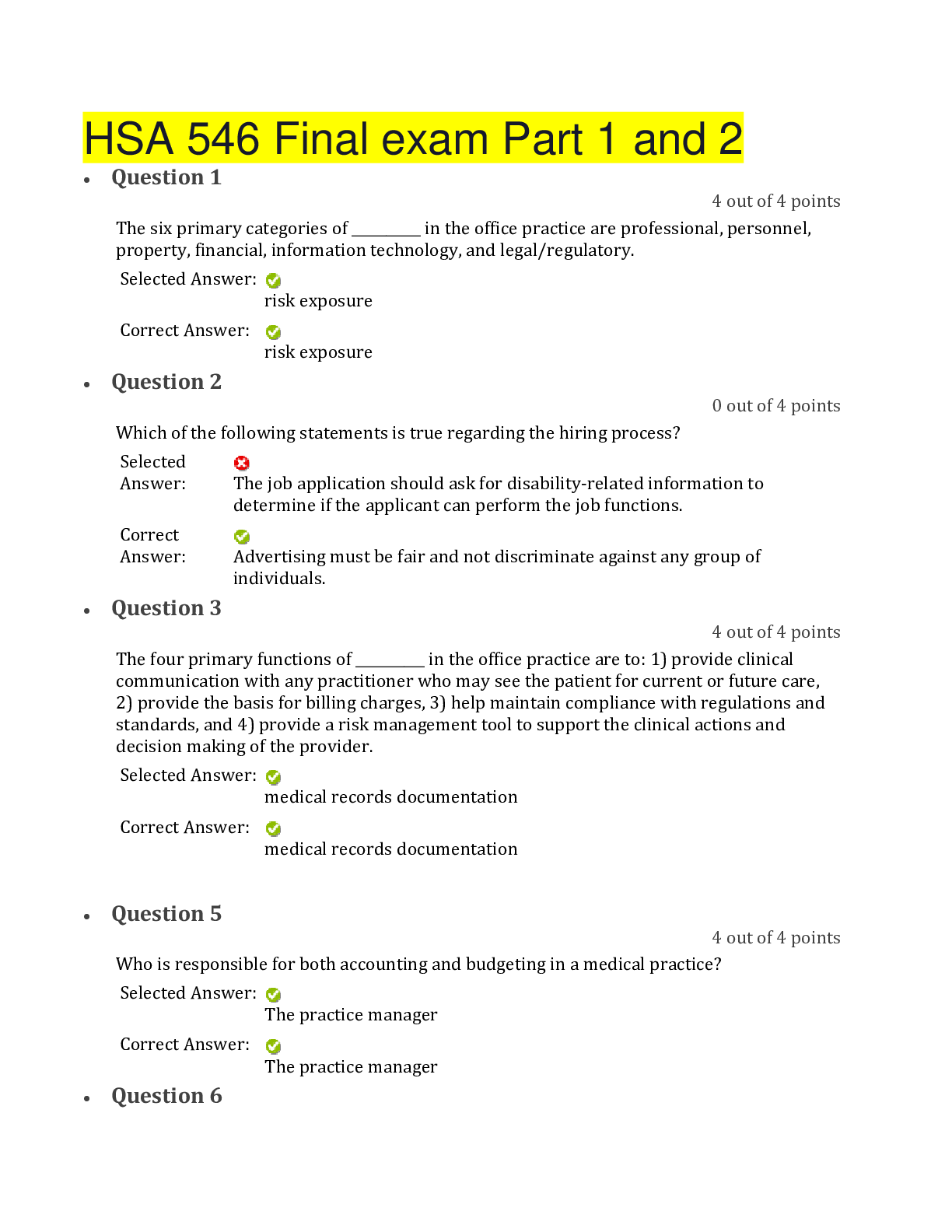Health Care > EXAM > NBME Practice Questions And Answers 2022 Test Bank Latest (All)
NBME Practice Questions And Answers 2022 Test Bank Latest
Document Content and Description Below
NBME Practice Questions And Answers 2022 Test Bank Latest A 67-year-old woman is hospitalized because of abdominal pain and persistent copious vomiting for 24 hours. Two weeks ago, she was hospitaliz... ed for treatment of atrial fibrillation; after cardioversion to a normal sinus rhythm, she began treatment with warfarin. Yesterday, at a follow-up visit, her INR was 6 (?? normal), and her medication was discontinued. She takes no other medications. Her temperature is 37°C (98.6°F), pulse is 120/min and regular, respirations are 20/min, and blood pressure is 100/78 mm Hg. The abdomen is distended and moderately tender; there is voluntary guarding in the epigastrium (??? source of pain) There are no masses, organomegaly, or obvious hernias. Rectal examination shows no abnormalities. Test of the stool for occult blood is negative. Her hemoglobin concentration has decreased from 13 g/dL yesterday to 7.8 g/dL today. An ECG shows a normal sinus rhythm. Which of the following is the most likely explanation for this patient's abdominal symptoms? Intramural hematoma of the proximal small bowel Internal small-bowel herniation Malrotation of the small bowel Intestinal ischemia from a cardiac embolus Intussusception of the small bowel Correct Answer: Intramural hematoma of the proximal small bowel A 4-year-old boy is brought to the physician by his parents because of fatigue and irritability over the past 2 months. The family visited relatives in rural Louisiana 5 months ago where the patient ran around barefoot. The child is active and appears normal. The conjunctivae are pale. Laboratory studies include a normal leukocyte count with 15% eosinophils. A stool preparation discloses the parasite egg shown. Which of the following is the most likely cause of fatigue and irritability in this patient? Myocarditis Circulating immune complexes Activation of lgE Central nervous system infestation Microcytic anemia Correct Answer: Microcytic anemia Two days after beginning primaquine for malaria prophylaxis, a 17-year-old African American boy is brought to the physician because of dark urine and yellowing of his eyes. His pulse is 88/min, respirations are 12/min, and blood pressure is 124/68 mm Hg. Examination shows scleral icterus and pale mucous membranes. His hemoglobin concentration is 10 g/dL. A blood smear shows erythrocyte fragments and Heinz bodies. Which of the following is the most likely explanation for these findings? Decreased production of β-globin chains Deficiency of glycosylphosphatidylinositol Deficiency of glucose 6-phosphate dehydrogenase Fragmentation of erythrocytes by fibrin strands Decreased porphobilinogen deaminase activity Correct Answer: Deficiency of glucose 6-phosphate dehydrogenase A one-day-old newborn male is found to have hemolytic disease of the newborn. Both parents are Rh-positive, mother is positive for IgG isohemagglutinins, while father is negative. Which of the following parental blood types most likely caused this condition? Mother: O and Father: AB Mother: AB and Father: O Mother: B and Father: O Mother: B and Father: A Mother: O and Father: AB Correct Answer: Mother: O and Father: AB One week after receiving 4 units of packed red blood cells for acute hemorrhage due to a gunshot wound, a 17-year-old male develops fatigue, jaundice. Laboratory results show the following:Hemoglobin 8.8 g/dL Hematocrit 28%, Serum total bilirubin 5 mg/dL Serum lactate dehydrogenase 120 U/L. Liver and kidney function tests are otherwise within normal limits. Which of the following is the most appropriate next step in diagnosis? Ultrasonography of the gallbladder Monospot test Serology for hepatitis B markers Direct and indirect antiglobulin (Coombs) tests Cytomegalovirus antibody titer Correct Answer: Direct and indirect antiglobulin (Coombs) tests A 6-month-old boy is brought to the physician because of left knee swelling for 24 hours. Three months ago, he had three large hematomas on his forehead that resolved without treatment (??). His two sisters and his mother have no history of similar symptoms. His mother's maternal uncle and her brother died (x-linked recessive) before the age of 30 years of massive cerebral hemorrhages. Physical examination shows deep ecchymosis over the buttocks and severe swelling of the left knee. The most likely explanation for these findings is a deficiency of which of the following? Factor V (proaccelerin): Factor V Leiden (FVL) results from a point mutation in the F5 gene, which encodes the factor V protein in the coagulation cascade. FVL renders factor V (both the activated and inactive forms) insensitive to the actions of activated protein C (aPC), a natural anticoagulant. As a result, individuals who carry the FVL variant are at increased risk of venous thromboembolism (VTE). However, FVL is extremely common in the population, and many individuals with the variant will never have a VTE. von Willebrand factor Factor VIII (antihemophilic factor) Factor XIII (transglutaminase) Factor I (fibrinogen): An abnormality of fibrinogen may be suspected if there is prolongation of the prothrombin time (PT), activated partial thromboplastin time (aPTT), and/or thrombin time (TT). In congenital afibrinogenemia (absence of detectable fibrinogen), bleeding often occurs in the neonatal period. Umbilical cord bleeding, which can be fatal, is the initial presentation in approximately 60 to 85 percent of cases. Other individuals with afibrinogenemia may have a later age of onset with bleeding in the skin, gastrointestinal tract, urinary tract, or central nervous system. Joint bleeding is relatively rare. Correct Answer: Factor VIII (antihemophilic factor) Three days after undergoing elective laparoscopic cholecystectomy for cholelithiasis, a 42-year-old woman has the onset of hematomas at all surgical sites. She was treated for deep venous thrombosis 3 years ago but was not taking any medications at the time of this admission. Results of preoperative laboratory studies were within the reference range. Prior to the operation, she received heparin and underwent application of compression stockings. Her initial postoperative course was uncomplicated. Heronly medication is ibuprofen. She is 163 cm (5 ft 4 in) tall and weighs 87 kg (192 lb); BMI is 33 kg/m2. Her temperature is 37.3°C(99.2°F), pulse is 94/min, respirations are 16/min, and blood pressure is 112/74 mm Hg. Examination shows mild hematomas at all surgical sites. The abdomen is soft and nontender. There is no organomegaly. Bowel sounds are normal. Laboratory studies show:Hemoglobin 10.3 g/dL Hematocrit 30%Leukocyte count 12,000/mm3 Platelet count 45,000/mm3 Which of the following is the most likely cause of this patient's current findings? Hypersplenism Acute intermittent porphyria Inhibition of cyclooxygenase von Willebrand disease Heparin-induced thrombocytopenia Correct Answer: Heparin-induced thrombocytopenia A 3-year-old girl with Down syndrome is brought to the physician because of a 1-week history of frequent nosebleeds, decreased appetite, and lethargy. She takes no medications. Her temperature is 38°C (100.4°F), pulse is 100/min, respirations are 20/min,and blood pressure is 80/45 mm Hg. Examination shows no other abnormalities except for pallor. Laboratory studies show:Hemoglobin 6.5 g/dL Hematocrit 19%Leukocyte count 100,000/mm3 Segmented neutrophils 15%Atypical lymphocytes 85%Platelet count 45,000/mm3 Which of the following is the most likely mechanism of these laboratory findings? Bone marrow hypoplasia Iron deficiency Reticuloendothelial phagocytosis of platelets Serum immunoglobulin A deficiency Infiltration of bone marrow by leukemic blasts Lymphocyte inhibitors of erythropoiesis Correct Answer: Infiltration of bone marrow by leukemic blasts A 30-year-old woman, gravida 2, para 1, comes for her first prenatal visit at 26 weeks' gestation. Uterine size is greater than expected for dates. Ultrasonography shows fetal hydrops. Which of the following is the most appropriate next step in diagnosis? Maternal Rh status with antibody screening Maternal HIV antibody test Cervical and urine cultures for group B Streptococcus Amniocentesis for measurement of α-fetoprotein concentration MRI of the fetus Correct Answer: Maternal Rh status with antibody screening A 65-year-old man has had increasingly severe headaches and diffuse muscle aches during the past 3 months. He also has a 1-month history of jaw pain when chewing food and decreasing visual acuity in his left eye. His temperature is 38°C (100.4°F). Visual acuity in his left eye is 20/100, and the left optic disc is slightly atrophic. His muscle strength is normal. Which of the following tests should be obtained next? CT scan of the head Examination of cerebrospinal fluid Measurement of erythrocyte sedimentation rate Electroencephalography Antinuclear antibody assay Correct Answer: Measurement of erythrocyte sedimentation rate A 10-year-old boy has had anemia since birth. His spleen is five times normal size. Splenectomy is indicated if the anemia is caused by which of the following disorders? Fanconi anemia Hereditary spherocytosis Glucose 6-phosphate dehydrogenase deficiency Thalassemia major Sickle cell disease Correct Answer: Hereditary spherocytosis A previously healthy 72-year-old man is brought to the physician because of weakness and fatigue. His hemoglobin concentration is 9.2 g/dl, leukocyte count is 5400/mm3, and platelet count is 350,000/mm3. A peripheral blood smear is shown. Which of the following is the most likely cause of these findings? Beta-Thalassemia major Gastrointestinal blood loss Aplastic anemia Vitamin B12 (cobalamin) deficiency Chronic myelogenous leukemia Correct Answer: Gastrointestinal blood loss A 48-year-old man comes to the physician because of increasing bronzing of his skin, weakness, and fatigue during the past 3 months. Physical examination shows bronzing of the skin, hepatomegaly, and small testes. Serum studies show: Which of the following best explains the findings in this patient? Ferrochelatase deficiency Increased erythropoietin production Ineffective erythropoiesis Transferrin deficiency Increased intestinal iron absorption Correct Answer: Increased intestinal iron absorption A 3-year-old boy and his 5-year-old brother bruise easily and have recurrent hemarthrosis. Both parents are healthy, but the mother has two younger brothers with the same symptoms and a maternal uncle who died at 8 years of age after mild head trauma. Partial thromboplastin time is prolonged. The most likely defect involves which of the following? Thrombin Factor XIII (transglutaminase) Factor VIII (antihemophilic factor) Factor V (proaccelerin) von Willebrand factor Correct Answer: Factor VIII (antihemophilic factor) An 81-year-old woman is admitted to the hospital because of a massive pulmonary embolism from a deep venous thrombosis. Her platelet count is 160,000/mm3. Appropriate pharmacotherapy is started. One week later, her platelet count is 55,000/mm3. The thrombocytopenia was most likely caused by a drug with which of the following mechanisms of action? Activates tissue plasminogen Selectively inhibits factor Xa Irreversibly inactivates cyclooxygenase Potentiates the action of antithrombin III Interferes with the carboxylation of coagulation factors Correct Answer: Potentiates the action of antithrombin III A 62-year-old woman with recurrent pulmonary emboli comes to the physician for a follow-up examination. Physical examination shows no abnormalities. Laboratory studies show a prothrombin time of 12 seconds. Warfarin therapy is begun. Which of the following clotting factors is the first to be decreased by 50% after the initiation of therapy? VII (proconvertin) XI (plasma thromboplastin antecedent) XII (Hageman factor) V (proaccelerin) VIII (antihemophilic factor) Correct Answer: VII (proconvertin) A 40-year-old man is evaluated because his skin is extremely sensitive to sunlight. Exposure to the sun causes the formation of vesicles and blisters on the skin, which frequently take weeks to heal. He is diagnosed with a disorder caused by the increased synthesis of compounds in the skin that are subject to excitation by visible light. Which of the following biochemical pathways is most likely defective in this patient? Riboflavin metabolism Melanin synthesis Heme synthesis Bilirubin degradation Bile acid synthesis Correct Answer: Heme synthesis A 53-year-old man, who recently returned from Africa, has fever, headache, and abdominal discomfort. He received appropriate vaccinations prior to the trip. His temperature is 39.4°C (103°F). Physical examination shows no other abnormalities. A Wright-stained peripheral blood smear is shown. Which of the following is the most likely diagnosis? Malaria Leishmaniasis Toxoplasmosis Trypanosomiasis Babesiosis Correct Answer: Malaria A 10-year-old boy is brought to the physician because of a 4-day history of nosebleeds and easy bruising. Three weeks ago, he had an upper respiratory tract infection. Physical examination shows ecchymoses over the upper and lower extremities. Laboratory studies show a hemoglobin concentration and leukocyte count within the reference ranges and a decreased platelet count. A bone marrow smear shows an increased number of megakaryocytes. Which of the following platelet abnormalities is the most likely cause of the findings in this patient? Decreased concentration of the Gp1b/iX complex Decreased synthesis of thromboxane A 2 Decreased concentration of the Gp Llb/llla complex Decreased binding of Gpla/lla (aJ3 1) to collagen Deficient binding of von Willebrand factor to the Gp1b/iX complex Antibodies directed against the glycoprotein IIb/IIIa complex Correct Answer: Antibodies directed against the glycoprotein IIb/IIIa complex A 14-year-old girl is brought to the physician because of a 4-month history of heavy menstrual flow. Menarche occurred at the age of 13 years. Menses have occurred at regular 30-day intervals. She has a history of frequent nosebleeds and easy bruisability. Her father has had problems with nosebleeds and clotting. Physical examination shows areas of mild gum bleeding and mild ecchymoses. Laboratory studies show: Which of the following is the most likely diagnosis? Hemophilia B Hemophilia A Thrombotic thrombocytopenic purpura Von willebrand disease Vitamin K deficiency Correct Answer: Von willebrand disease A previously healthy 20-year-old woman comes to the emergency department because of a 2-week history of fever, shaking chills, headaches, fatigue, and joint and muscle pain. She recently spent the summer working as a lifeguard on Long Island, New York. She has never traveled outside the USA. She underwent splenectomy for injuries sustained in a motor vehicle collision at the age of 6 years. Her temperature is 39.1°C (102.4°F). Physical examination shows no other abnormalities. A peripheral blood smear shows small intraerythrocytic rings; the result of a polymerase chain reaction test for Plasmodium is negative. This patient most likely acquired the causal organism via a bite from which of the following? Tick Black fly Mite Mosquito Bedbug Correct Answer: Tick A 25-year-old woman comes to the physician for a routine follow-up examination. Two years ago, she underwent splenectomy as a result of injuries sustained in a motor vehicle collision. Physical examination shows no abnormalities. A complete blood count shows target erythrocytes. This finding is most likely the result of loss of function of which of the following portions of the spleen? Germinal centers Perivascular lymphocytes Red pulp Endothelial cells of the cortex Splenic stromal connective tissue Correct Answer: Red pulp A 55-year-old woman develops a headache, temperatures to 40°C (104 °F), a stiff neck, and confusion. Her spleen was removed due to injuries sustained in a motor vehicle collision 7 months ago. Which of the following organisms is most likely to be cultured from the patient's cerebrospinal fluid? Mycobacterium tuberculosis Streptococcus pneumonia Haemophilus influenzae Cryptococcus neoformans Borrelia burgdorferi Correct Answer: Streptococcus pneumonia A 35-year-old metal worker collapses after exposure to an unknown chemical at a factory. He is dyspneic but is noncyanotic and smells of burnt almonds. The most appropriate next step is to administer which of the following? Physostigmine Ethanol Erythropoietin Hyperbaric oxygen Amyl nitrite Correct Answer: Amyl nitrite A 42-year-old woman comes to the physician for an examination prior to employment. She has no history of major medical illness. Her vital signs are within normal limits. Physical examination shows no abnormalities. Laboratory studies show: Which of the following is the most likely diagnosis? Aplastic anemia Beta-thalassemia minor Folic acid deficiency Vitamin B12 (cobalamin) deficiency Sickle cell disease Correct Answer: Beta-thalassemia minor A 30-year-old woman has had Hodgkin disease that was diagnosed 10 years ago and was treated with radiation and chemotherapy for a 6-month period. She has remained in remission for 10 years. She now feels weak and has petechiae and ecchymoses. A diagnosis of acute myelogenous leukemia is made. Which of the following best explains this course of events? The patient has a genetic defect in the ability to repair DNA damage The patient had both Hodgkin disease and acute leukemia at the time of initial diagnosis, but the leukemia remained dormant for several years Therapy for Hodgkin disease causes mutations in hematopoietic stem cells, and one mutant cell progresses to leukemia The patient has inherited a predisposition to develop malignancies caused by Epstein-Barr virus Hodgkin disease was not cured by the treatment, and surviving neoplastic cells changed to acute leukemia Correct Answer: Therapy for Hodgkin disease causes mutations in hematopoietic stem cells, and one mutant cell progresses to leukemia A 38-year-old man is admitted to the hospital after sustaining a gunshot wound to the abdomen. Broad-spectrum antibiotic therapy is initiated for complications from fecal contamination of the peritoneal cavity. He has been taking warfarin since receiving an artificial heart valve 6 years ago because of endocarditis secondary to intravenous drug use. During the next 6 weeks, the warfarin dosage required to maintain his prothrombin time progressively decreases. Which of the following best explains this finding? Vitamin K deficiency caused by bacterial overgrowth in the small intestine Decreased INR caused by hepatitis B infection Septic shock caused by a facultative anaerobe such as Escherichia coli Vitamin K deficiency caused by depletion of the normal gut flora Septic shock caused by an anaerobic commensal such as Bifidobacterium species Vitamin K deficiency caused by depletion of the normal gut flora Correct Answer: Vitamin K deficiency caused by depletion of the normal gut flora A 2-month-old girl is brought to the physician for a follow-up examination 2 days after a complete blood count was found to be abnormal. Her blood group is A, Rh-positive. She was born at term to a healthy 23-year-old woman whose blood group is 0, Rh-positive. Birth weight was 3890 g (8lb 9oz). Pregnancy and delivery were uncomplicated. The patient has been active and feeding well. Her temperature is 37.6° C (99.7°F), pulse is 120/min, and respirations are 30/min. Physical examination shows no abnormalities. Laboratory studies done since birth are shown. Severe combined immunodeficiency DiGeorge syndrome Alloimmune hemolytic disease of the newborn Congenital neutropenia Congenital cytomegalovirus infection Correct Answer: Congenital neutropenia A 14-year-old boy has had fatigue, intermittent right lower quadrant abdominal pain, diarrhea, and a 5-kg (11-lb) weight loss over the past 6 months. A diagnosis of inflammatory bowel disease limited to the terminal ileum is made. Absorption of which of the following is most likely to be impaired in this patient? Iron Vitamin B12 (cobalamin) Vitamin B1 (thiamine) Vitamin B2 (riboflavin) Folic acid Correct Answer: Vitamin B12 (cobalamin) Which of the following best explains why deoxygenated blood can carry more carbon dioxide for a given Pco2 than oxygenated blood? Deoxyhemoglobin has a lower pKa than oxyhemoglobin Deoxyhemoglobin has a lower capacity to form carbamino compounds than oxyhemoglobin Deoxyhemoglobin is a better buffer of hydrogen ions than oxyhemoglobin Oxyhemoglobin binds nitric oxide with a higher affinity than deoxyhemoglobin Deoxyhemoglobin does not bind to 2,3-bisphosphoglycerate as efficiently as oxyhemoglobin Oxygen and carbon dioxide compete for the same binding site in hemoglobin Correct Answer: Deoxyhemoglobin is a better buffer of hydrogen ions than oxyhemoglobin An 18-year-old woman is broug [Show More]
Last updated: 1 year ago
Preview 1 out of 229 pages

Reviews( 0 )
Document information
Connected school, study & course
About the document
Uploaded On
Jul 26, 2022
Number of pages
229
Written in
Additional information
This document has been written for:
Uploaded
Jul 26, 2022
Downloads
0
Views
110

.png)
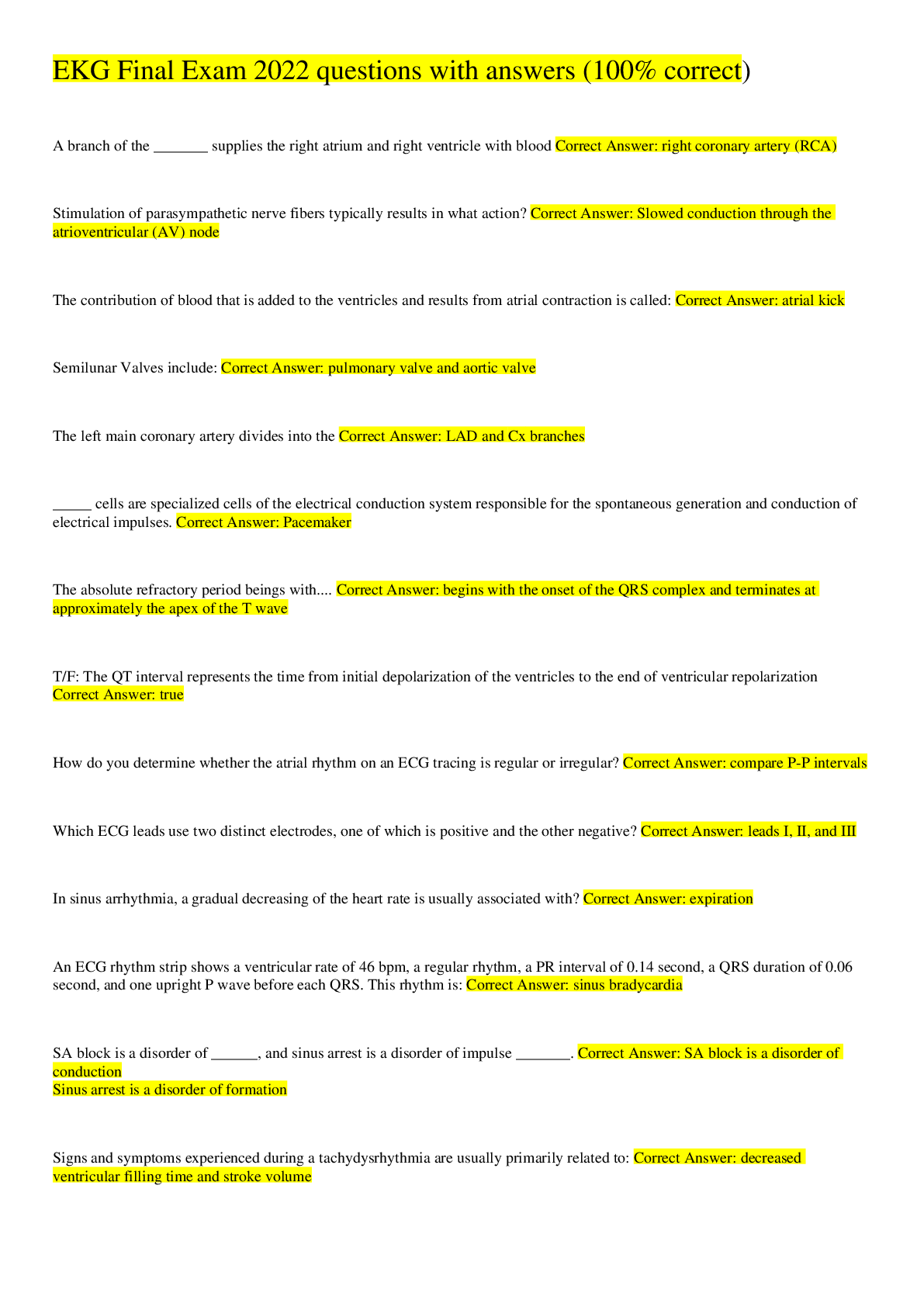


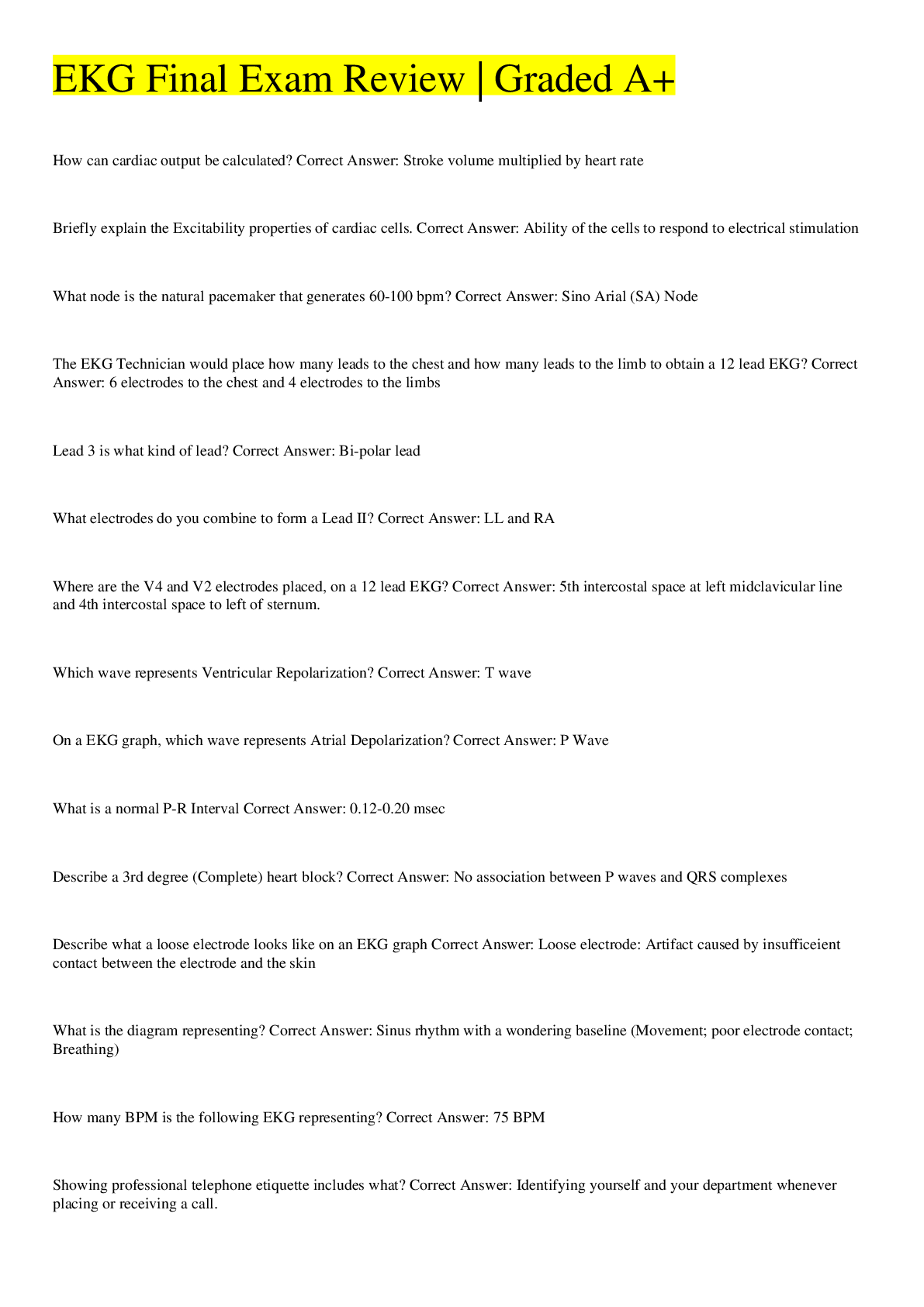



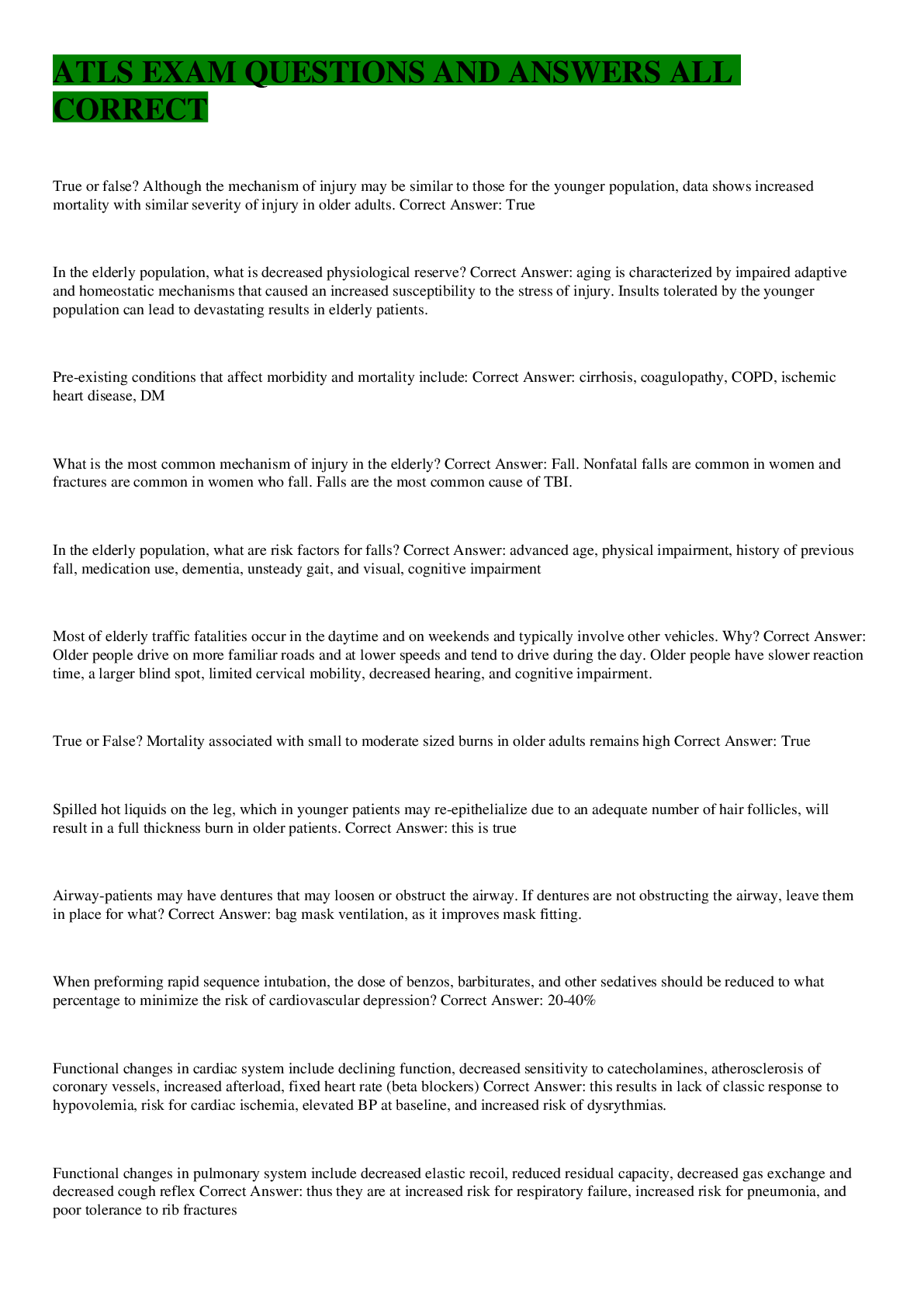

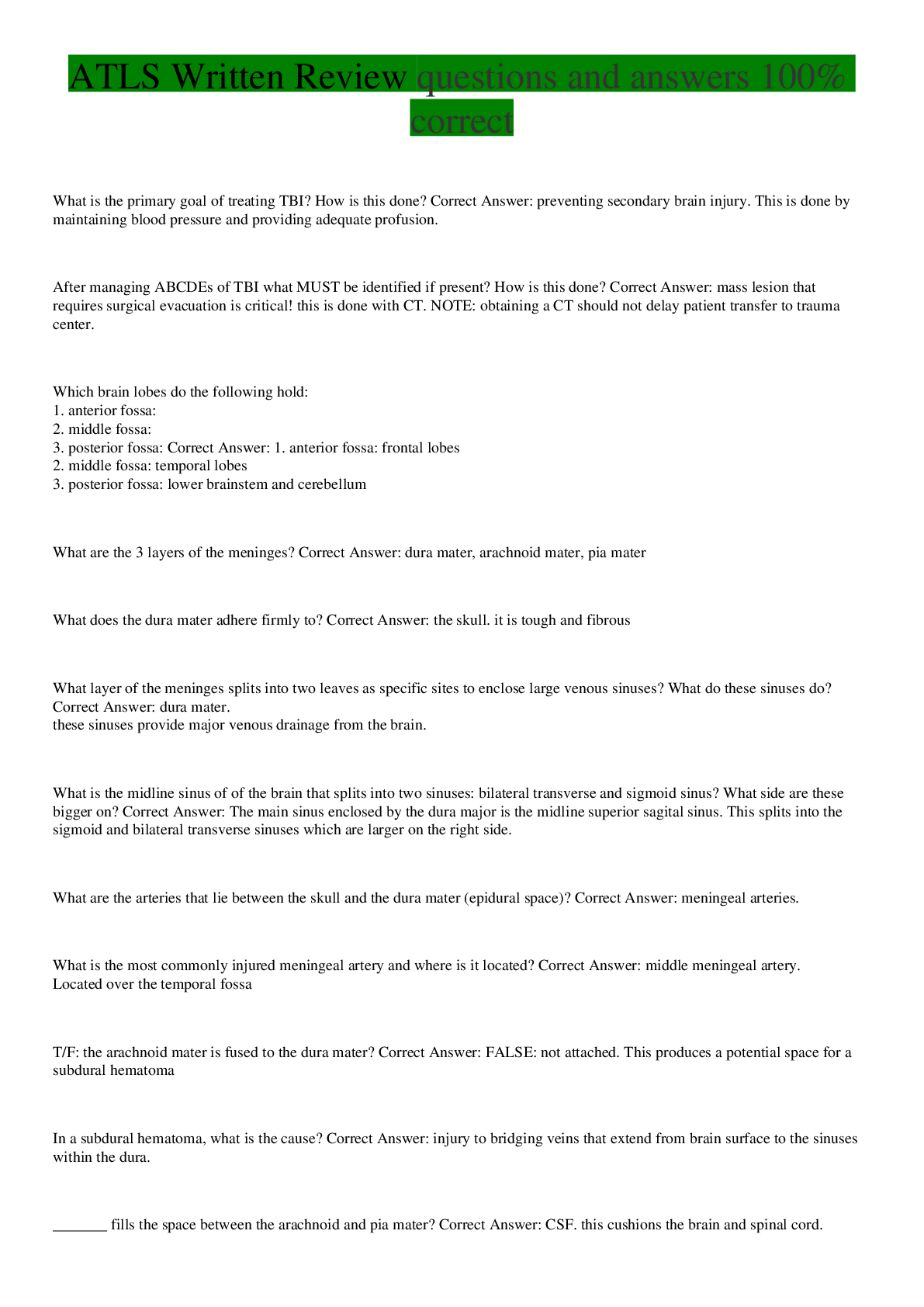

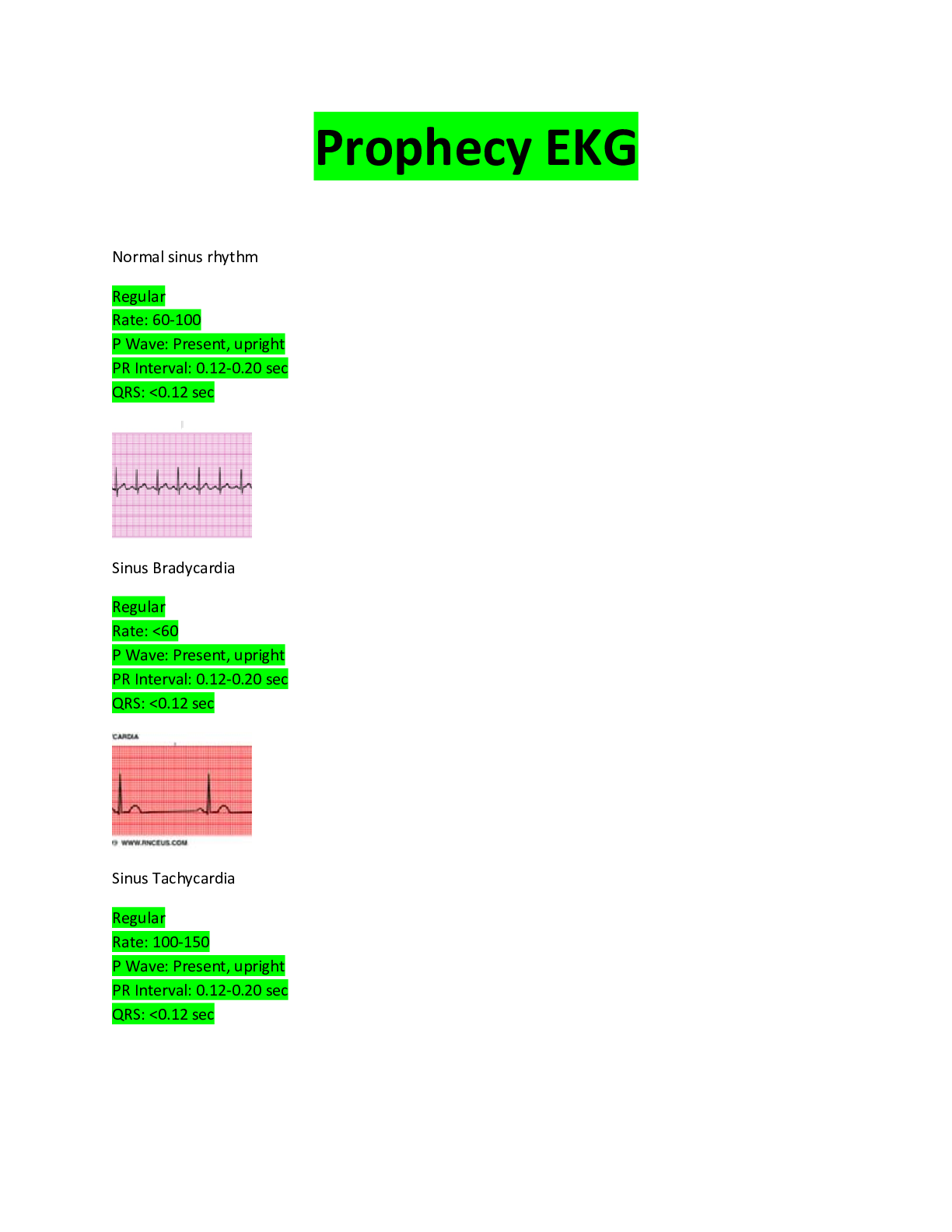
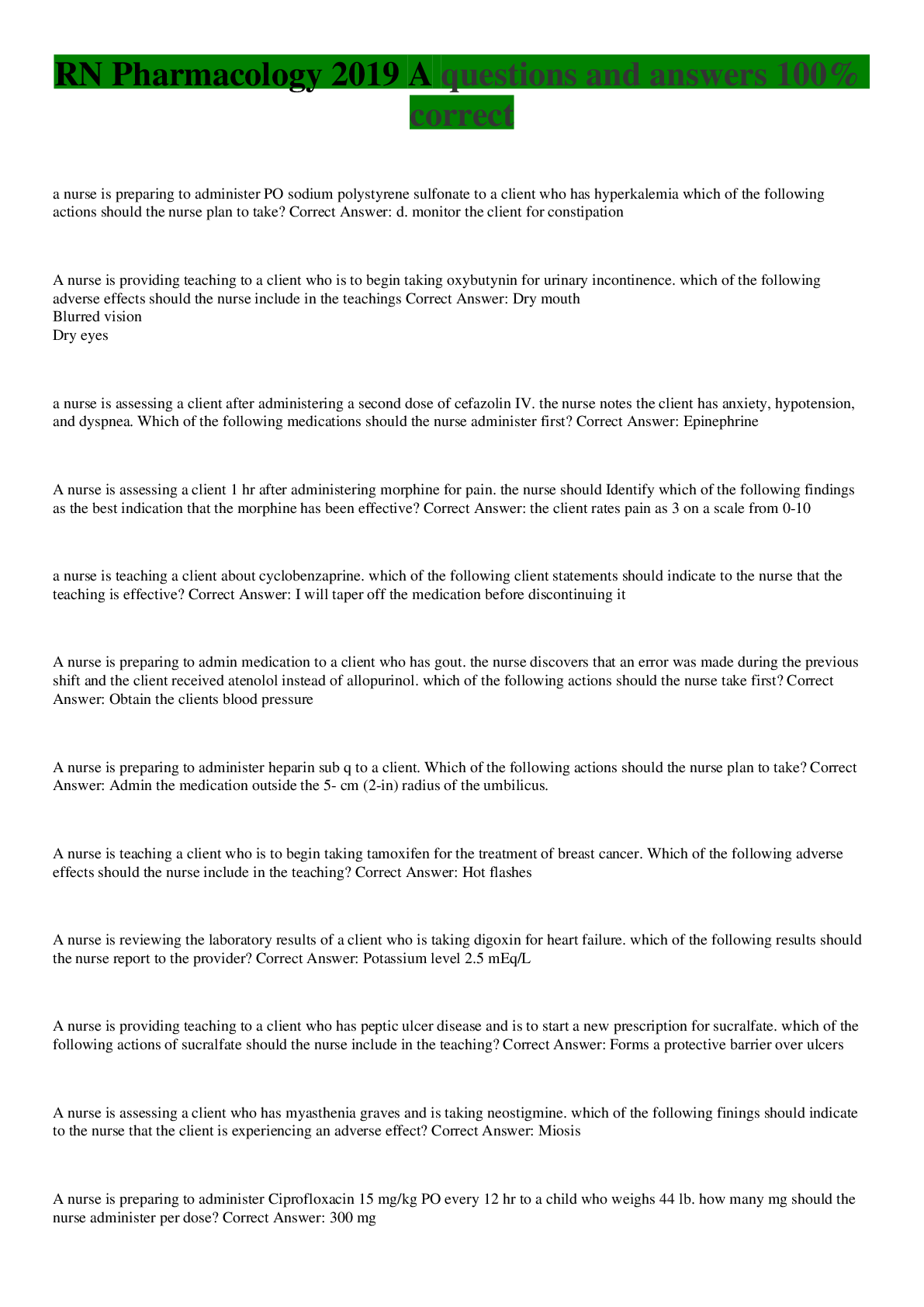






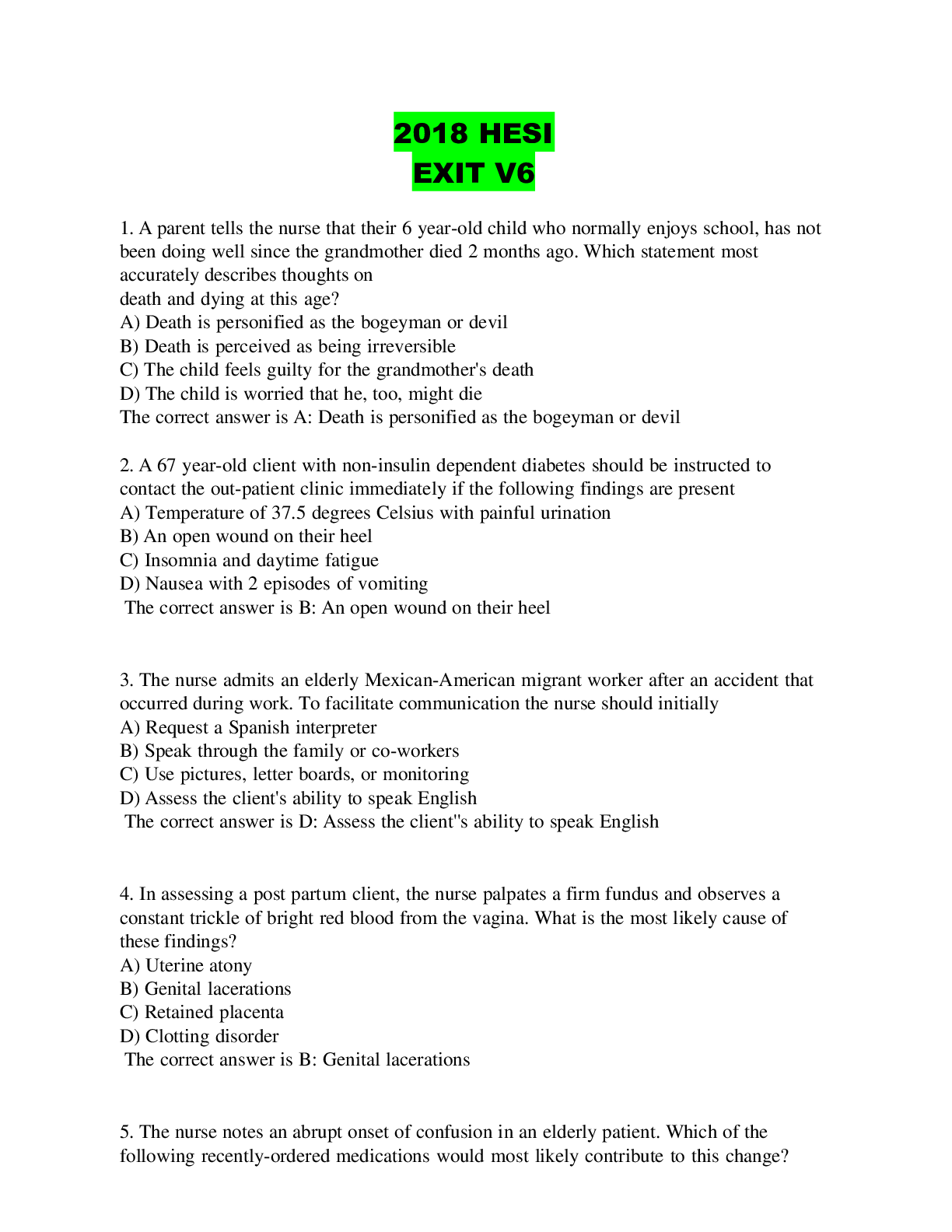


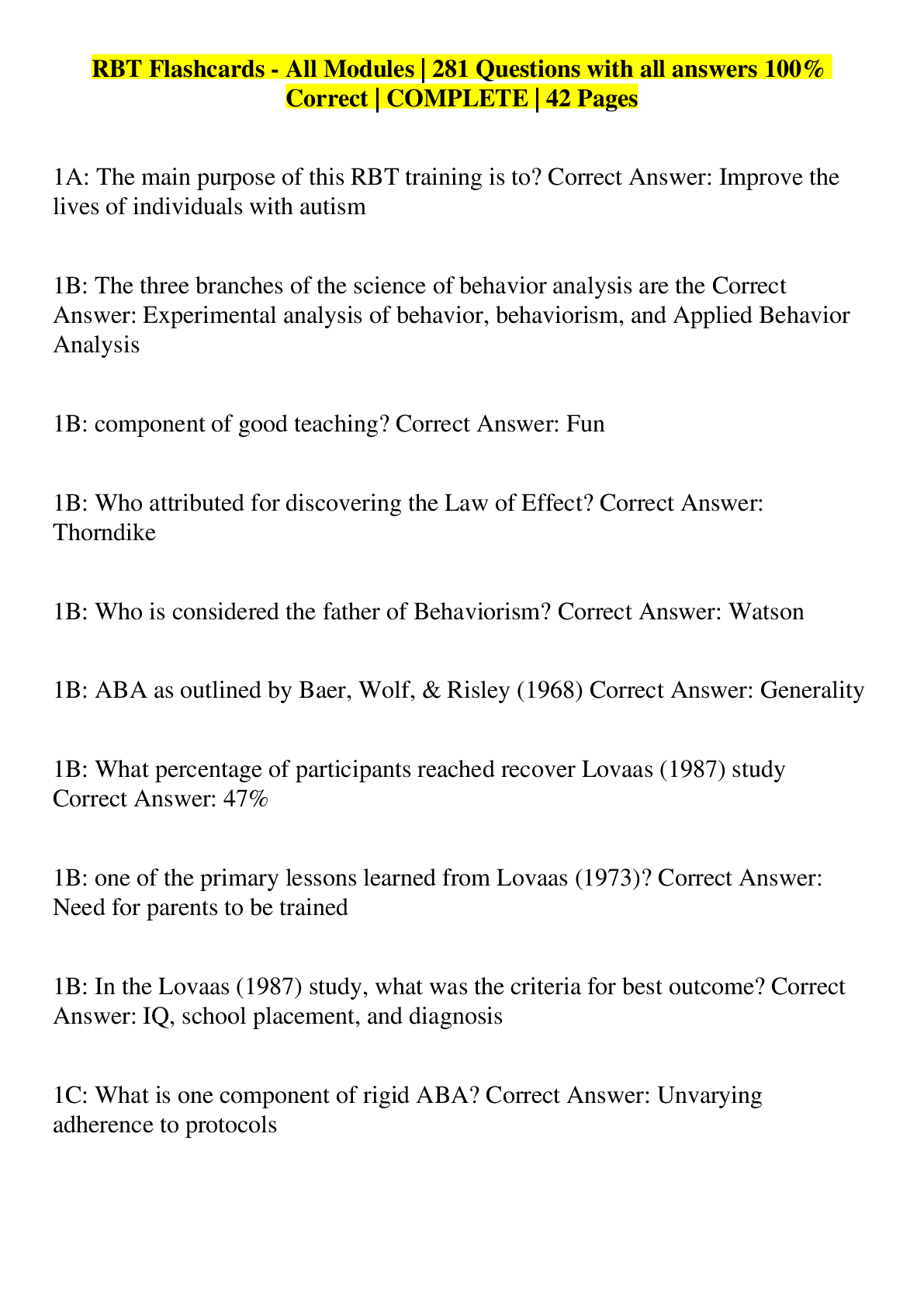





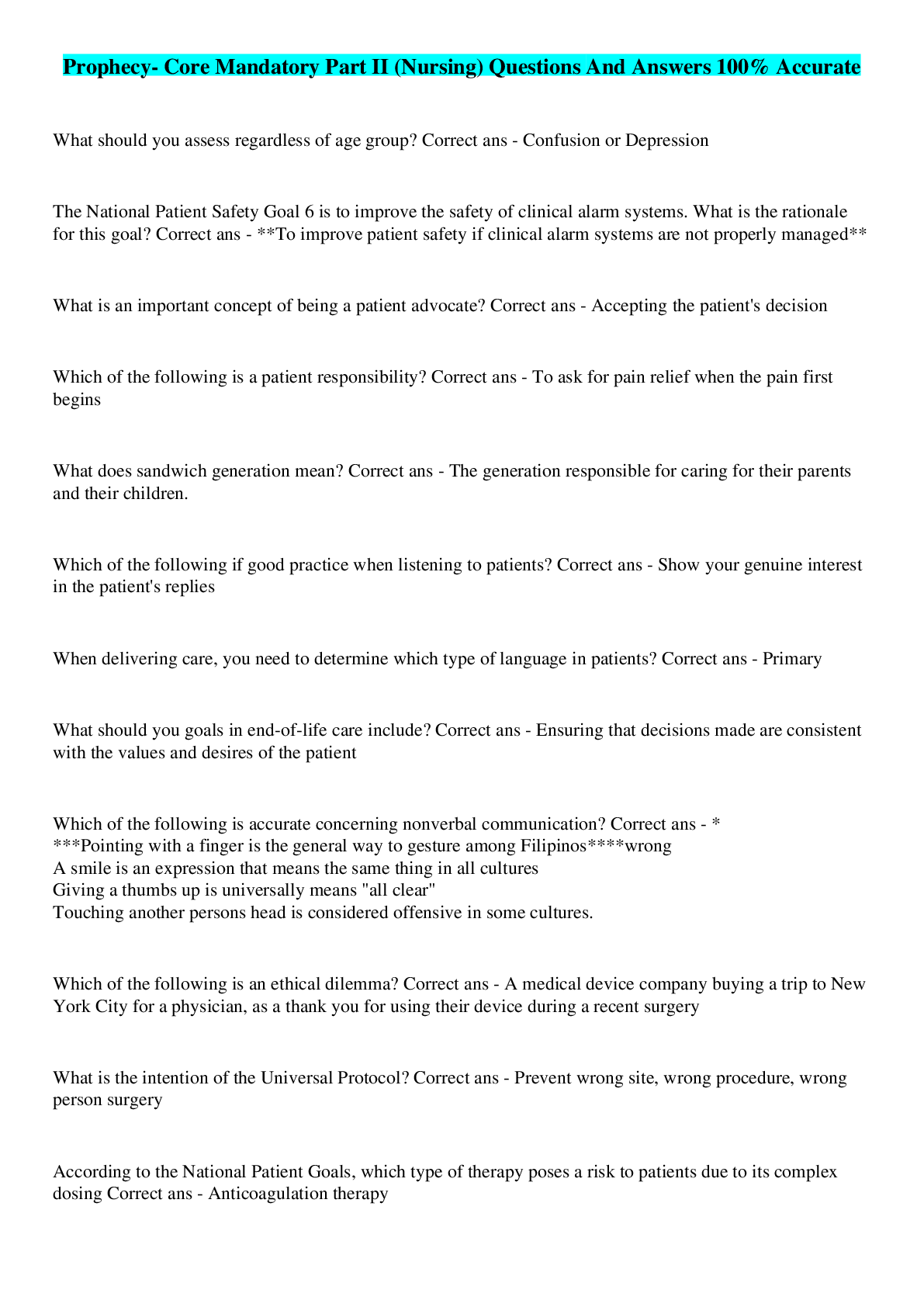

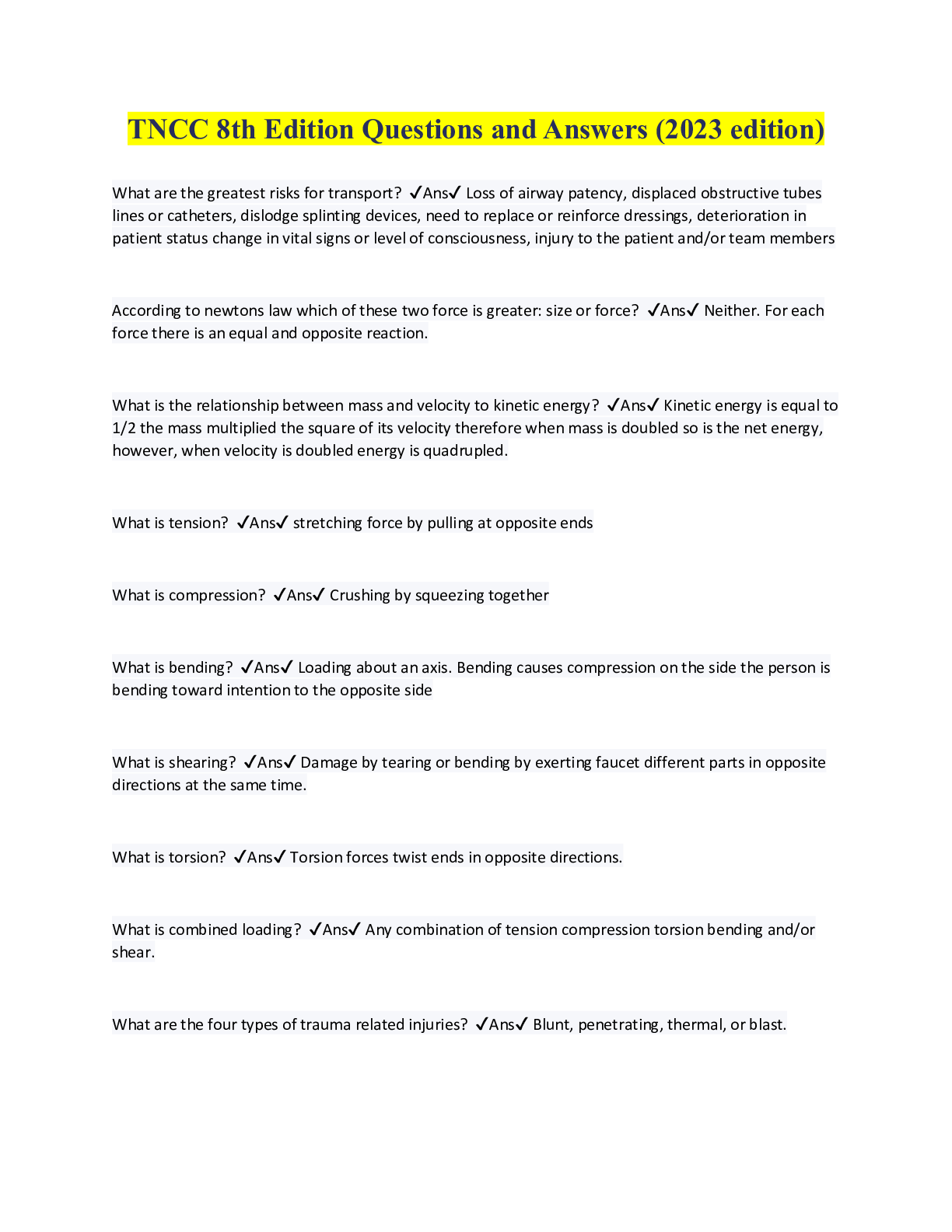
.png)
